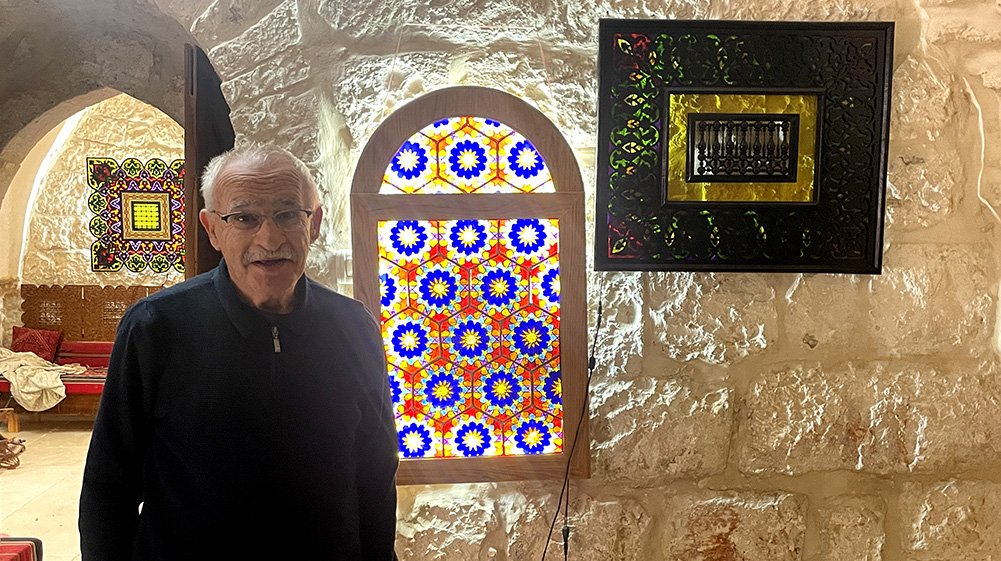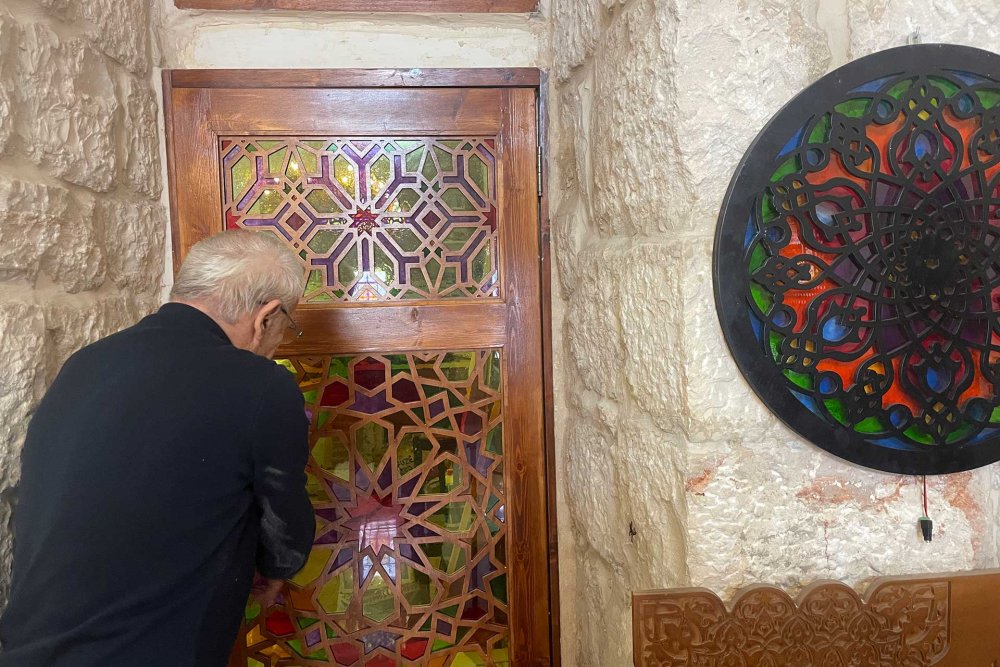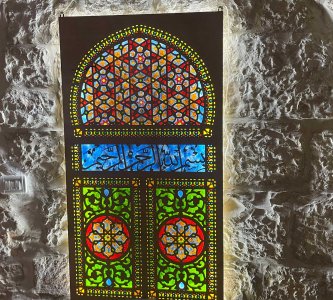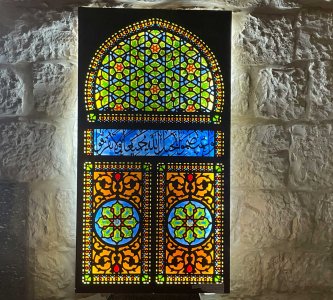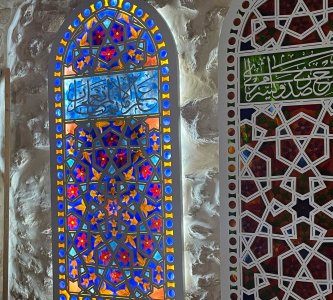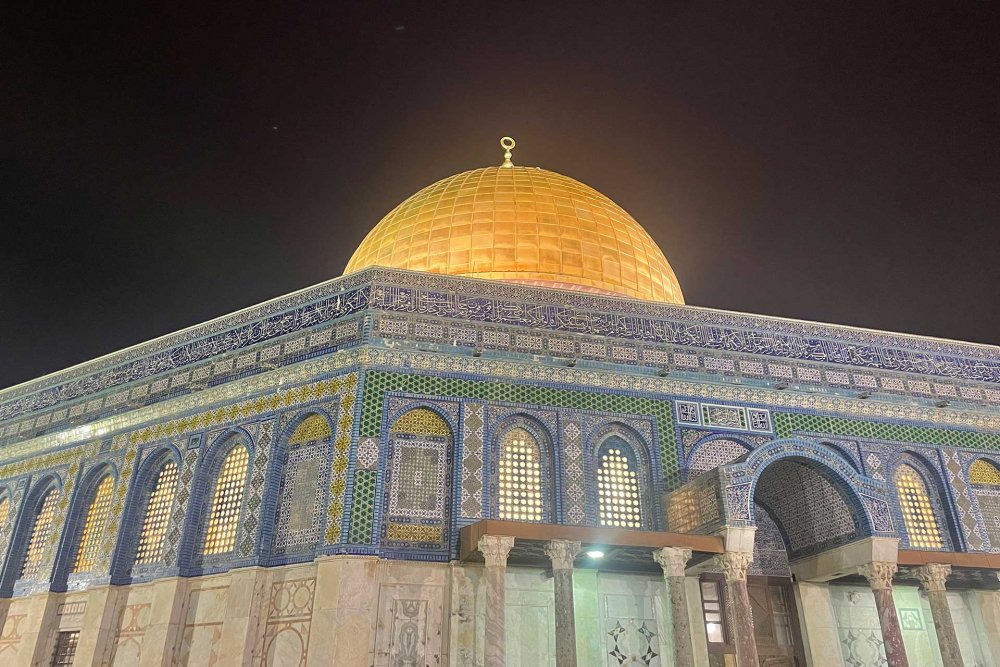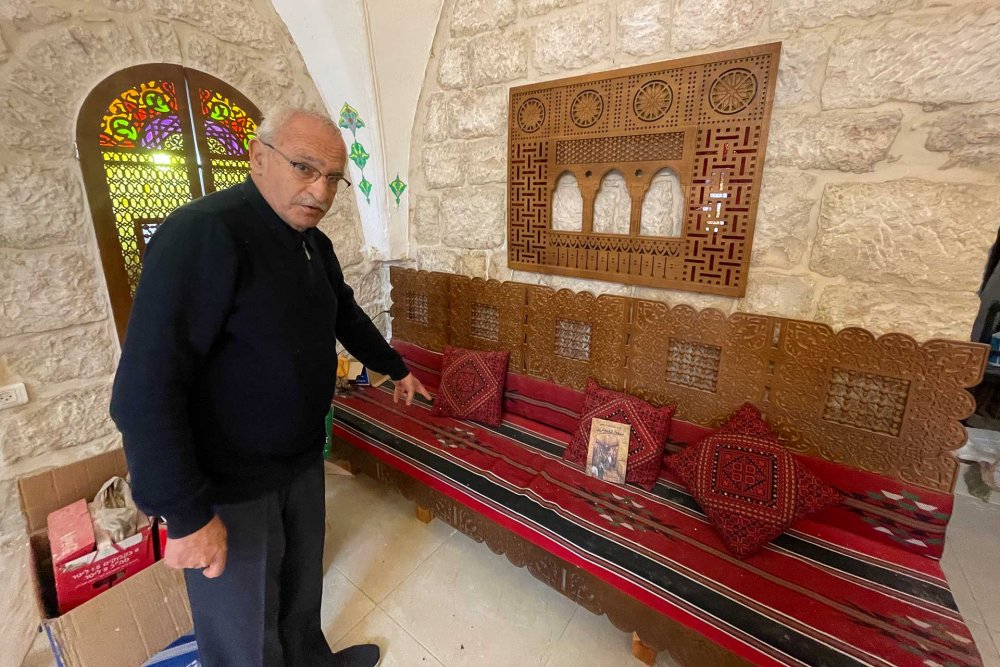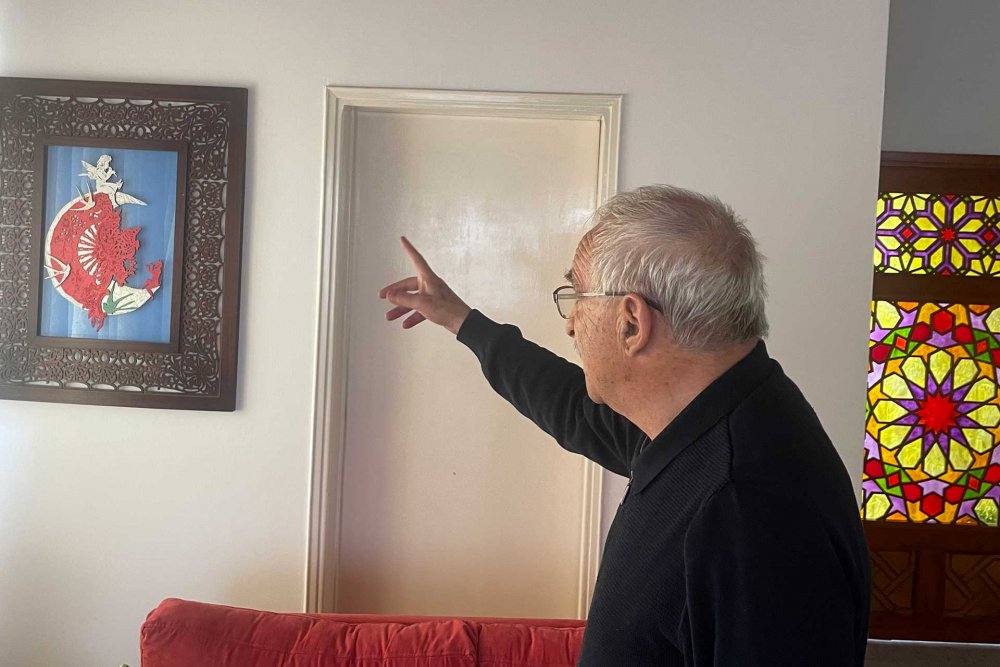At age 65, after years of full-time professional work, Palestinian Jerusalemite writer and researcher Azzam Abu Saud began devoting his time to recreating and raising awareness about the beauty of Arab art. Jerusalem Story visited him at his house and studio in the East Jerusalem neighborhood of Ras al-Amud on March 21, 2024, to learn more about his literary and artistic work. In this conversation, he shares his thoughts on the power that architecture has on identity.
Growing Up in Jerusalem
Born on June 4, 1948, Azzam grew up in the Old City of Jerusalem and attended al-Rashidiyya secondary school. He credits living in the Old City with providing him with skills that surpassed the education offered within school systems. “Growing up, my level in English was as good as those who studied at superior (private) schools, such as the Collège des Frères and St. George. This was because I lived in the Old City of Jerusalem, next to the Haram al-Sharif. The fact that I was ibn al-Quds, a child of Jerusalem, compelled me to converse in English with all sorts of people. It was enough to make me well-versed and competent in general,” Azzam said.1
Azzam pursued his higher education at Cairo University and earned a bachelor’s degree in commerce in 1971. He then went on to study association management at US-affiliated universities.
Returning Home to Serve a Community
Azzam went on to have a productive career. From 1982 to 1996, he was the director of the tender and supplies department at Birzeit University. For two of those years, he was a representative for academic journal publishers of renowned universities. In 1999, he became director of the Jerusalem Arab Chamber of Commerce and Industry, a position in which he served until his retirement in 2013.
Azzam was also a board member for many of Jerusalem’s important cultural and academic institutions, including the Arab Thought Forum (ATF) and the Palestinian National Theatre, el-Hakawati. He also established a name for himself as a writer and researcher, publishing hundreds of articles on various platforms, and was a regular columnist for Al-Quds newspaper, sharing his expertise on issues mostly related to Jerusalem and its oral history. He also published books in Arabic that relate to the daily life of Palestinians, most of which were delivered in a straightforward and sometimes satirical style, including the 2004 Tar al-hamam (Pigeons flew) and the 2009 Suq al-‘attarin (The spice market).
Retirement Opens a New Chapter
Upon retiring in 2013, Azzam devoted his time to reviving art, particularly arabesque designs that had been abandoned. With his historic knowledge and experience in Jerusalem, he found it crucial to enlighten people about the importance of conserving and creating authentic art.
Today, at age 75, he dedicates his time to reviving arabesque decorative art. His work includes wood carving, glass drawing, coloring, and meshing. Inspired by Jerusalem, Azzam is passionate about preserving the rich and authentic Arab character of his beloved city.
Arabesque: A Childhood Passion That Returned in His Senior Years
Growing up in the Old City of Jerusalem, Azzam was captivated by the Arab and Islamic art around him. His uncle used to carve on wood, and he would partake in this activity at a young age. When he was barely 14 years old, Jordanian institutions began a renovation process for the Dome of the Rock to replace the Ottoman tile on the dome’s exterior with aluminum-bronze plates covered in gold leaf. Azzam recalls the five-year project between 1959 and 1964 and shared:
Our house was just next to the mosque, so this got me connected with the Italian artists who were delegated to carry out the artwork. I was both curious and interested and they let me help them. That was how I learned some of the basic skills of designing windows by hand.
Soon after, Azzam developed a passion for Arab crafts and began to study their evolution over time. He was mesmerized by the designs of arabesque doors, especially the mashrabiyya, an element that is characteristic of traditional architecture in the Islamic world, and window or balcony designs, which are often enclosed with carved wood and sometimes enhanced with stained glass. He also appreciated the sitting room designs, known in Arabic as majlis, and low wooden benches.
Eventally, Azzam taught himself how to replicate these designs and dedicated an entire space to display different works of art at his studio in Ras al-Amud.
Dome of the Rock: An Architectural Masterpiece
Azzam finds that being in the proximity of the Dome of the Rock shapes the identity of Arab Jerusalemites. As he sees it, their status as permanent residents of Israel holding Israeli IDs as well as Jordanian passports without Palestinian citizenship due to the Oslo Accords, which kept the issue of Jerusalem on the back burner, has collectively placed them in limbo. In his view, the documents most Palestinian Jerusalemites carry are merely “walking papers.”
“The identity of Palestinian Jerusalemites is very much associated with the Muslim and Christian holy sites; this is the only thing that unites us,” Azzam told Jerusalem Story. Most of the riots, protests, demonstrations, and uprisings that escalate into national issues have had al-Aqsa Mosque at their heart.
“Christians, too, find that the symbolic presence of al-Aqsa Mosque is part and parcel of their identity. It is much like I, as a Muslim, feel toward the Holy Sepulchre Church. As a Jerusalemite Arab, I feel very much disturbed when the Israeli forces prevent me from accessing the church during Sabt al-Nur, the Holy Saturday ceremony,” Azzam reflected.
“I personally get invited to Christian ceremonies such as at the Notre Dame Church by the New Gate during Easter. I’m always impressed how we as Muslims and Christians celebrate together. When Israeli policies prevent me and Christians themselves from attending the Holy Saturday ceremonies, I see this as a personal insult to our shared collective presence on this land,” he added.
Identity through Art and Design
In Architecture of Happiness, Swiss-born British author Alain de Botton presents vivid descriptions of the ways in which buildings affect how human beings feel about themselves and manifest their ideals on the ground:
In essence, what works of design and architecture talk to us about is the kind of life that would most appropriately unfold within and around them. They tell us of certain moods that they seek to encourage and sustain in their inhabitants. While keeping us warm and helping us in mechanical ways, they simultaneously hold out aninvitation for us to be specific sorts of people. They speak of visions of happiness.2
It is perhaps in this nature that Azzam’s vision comes to life. He shared:
When I worked at the Chamber of Commerce, I really tried to develop the concept of reviving the crafts and aligning them with heritage and tourism in Jerusalem. I feel disappointed when I see how our souvenir shops import thousands of products for sale from China.
Those who visit Jerusalem would want to see original, authentic, and local art pieces that exemplify the place they’re at. We are in no way lacking in artworks that speak for our rich heritage and culture.
Arab art, Azzam stressed, is highly advanced; “each generation echoed the one before, and each added its personal touch as per culture and religion.”
Islamic art steered away from figurative images or statues. Muslims associated human figures with pagan-like inclinations of worship and thus, they replaced them with shapes drawn from nature. “This is why you will see flowers and plants surrounding Islamic artworks with geometric motifs and stylized vegetal decoration,” Azzam explained.
Islamic geometric design, he affirmed, is so vast that it could be described as a form of science: “There are institutes and courses around the world that teach geometric design. This field constitutes a scientific study of its own.”
Azzam believes that the Umayyad caliphate, which ruled Mecca’s Quraysh tribe from 661 to 750 CE, offers some unique examples of Islamic art. It was during that time the Dome of the Rock was built, in 691, with mosaics, marble, metalwork, and colored glass.3 “It is worth reflecting on how the Umayyads, whose houses were mostly made of clay and hay, had managed to create such outstanding art as intelligibly manifested in the breathtaking design of the Dome of the Rock in such a short time,” Azzam said. “The answer,” as he explained it, “is that Byzantine motifs influenced them.”
The Enmeshment of Art Designs (Churches and Mosques)
Azzam asserts that the first geometric design was introduced by the Arabs, although there was always enmeshment with the Greek and Byzantine art forms. Prior to Islamic design, drawings were mostly presented in circles or star shapes. The arabesque style introduced rectangular and square shapes. “The general designs don’t ‘belong’ to one or another,” he affirmed. “Rather, one affected the other. Even within the Mediterranean and Arab world, there were distinctive styles in Damascus, Aleppo, and Cairo yet they were all inspired by civilizations that preceded them.”
The arabesque designs of al-Aqsa Mosque incorporated designs of Roman-Byzantine churches as well as Persian-inspired styles of vegetal arabesque. “Inspirations included the colored marbles and mosaic designs of Central Asia, such as in Khorasan and Tashkent,” he clarified. One century ago, Armenian ceramicists from Kutahya were hired to complete restoration work on the Dome of the Rock.
Azzam believes there shouldn’t be an issue in making changes to conventional art design as long as it is beautiful. Al-Aqsa Mosque has undergone various transformations throughout history: It was destroyed by several earthquakes and ruined during the Crusader era. Eventually, when the Ayyubid dynasty army defeated the Crusaders under the rule of its founder, Salah al-Din al-Ayyubi, and captured Jerusalem in 1187 during the Battle of Hattin, they were determined to return the site to its original function and removed all that they saw as “filthy” Crusade remnants. “This goes to show that beauty takes precedence over the source and is eventually allowed to integrate in the final work,” Azzam expressed.
Ongoing Appreciation of Arab Design
Azzam maintains that decorative artworks should not be limited to mosques, churches, or fancy buildings. Rather, they should be incorporated into public display and used in practical ways such as in homes and living areas. Why? “Exterior design displays our identity as Arabs and gives visible evidence of our presence on this land,” he explained.
Today, Azzam spends most of his time immersed in his art activities of carving wood, drawing, and coloring while listening to classical music in his working rooms in Ras al-Amud, which at this point resemble a museum. “Forgive the mess,” he apologized as he walked to his studio. “I haven’t entered this space or managed to get any work done since the war on Gaza started, it’s been too depressing,” he sighed.
His face lit up, however, when he spoke of the astounding beauty he had witnessed through the years, such as Andalusia’s Mosque-Cathedral of Cordoba, the decorative architectures of Cairo, the Umayyad Mosque of Damascus, and the ever-enchanting Dome of the Rock, which he can spot from the roof of his Jerusalem home.
Notes
Azzam Abu Saud, interview by the author, March 21, 2024. All subsequent quotes from Abu Saud are from this interview.
Alain de Botton, The Architecture of Happiness (London: Hamish Hamilton, 2006), 72.
Dusan Nikolic, “Art of the Umayyad Caliphate: Mosques, Domes, & Desert Palaces,” The Collector, November 1, 2022.

